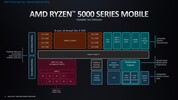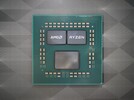AMD Ryzen 5 5625U vs AMD Ryzen 5 5500U vs AMD Ryzen 7 5700U
AMD Ryzen 5 5625U
► remove from comparison
The AMD Ryzen 5 5625U is a processor for thin and light laptops based on the Cezanne generation. It is part of the "Barcelo" refresh in early 2022 and offers 100 MHz higher boost clock for the CPU cores compared to the old Ryzen 5 5600U. The R5 5625U integrates six of the eight cores based on the Zen 3 microarchitecture and is the third fastest U-5000-series processor at launch. The cores are clocked at 2.3 (guaranteed base clock) to 4.3 GHz (Turbo) and support SMT for a total of 12 threads. The chip is manufactured on the modern 7 nm TSMC process.
In addition to the six CPU cores, the APU also integrates a Radeon RX Vega 7 integrated graphics card with 7 CUs at up to 1800 MHz. The dual channel memory controller supports DDR4-3200 and energy efficient LPDDR4-4266 RAM. Furthermore, 16 MB level 3 cache (up from 8 MB at the 4800U) can be found on the chip.
Performance
The average 5625U in our database is in the same league as the Core i5-1255U, Core i5-1335U, Core i5-1345U and also the Ryzen 5 7530U, as far as multi-thread benchmark scores are concerned. This is a decent result, as of Q3 2023.
Your mileage may vary depending on how high the CPU power limits are and how competent the cooling solution of your system is.
Power consumption
This Ryzen has a default TDP of 15 W (also known as the Power Limit 1). Which is a little too high to allow for passively cooled designs.
The APU is built with TSMC's 7 nm process for higher-than-average, as of mid-2022, energy efficiency.
AMD Ryzen 5 5500U
► remove from comparison
The AMD Ryzen 5 5500U is a hexa-core APU of the Lucienne product family designed for use in ultra-thin, upper mid-range laptops. The processor was unveiled in H1 2021; its six CPU cores are based on the Zen 2 microarchitecture. The cores run at 2.1 GHz (base clock speed) to 4 GHz (highest Boost frequency possible) and feature the thread-doubling SMT technology for a total of 12 threads. The chip is manufactured on the modern 7 nm TSMC process.
One could be forgiven for thinking Ryzen 5 5500U is a renamed Ryzen 5 4500U - which is not the case. Ryzen 5 5500U is most similar to Ryzen 5 4600U, the most noteworthy difference between the two being the faster iGPU model of the former.
In the meantime, Ryzen 5 5600U got a little more lucky; it is based on the newer Zen 3 architecture and it also has higher clock speeds than what a 5500U can boast of.
Architecture
While Ryzen 5 5500U and Ryzen 7 5700U are Zen 2-based processors, the neighbouring Ryzen 5 5600U and Ryzen 7 5800U use AMD's brand-new Zen 3 architecture. This makes the former two a generation older than their names suggest. Still, Zen 2 is nothing to sneeze at, with its high performance-per-Watt and performance-per-MHz figures.
Ryzen 5 5500U supports dual-channel DDR4-3200 and quad-channel LPDDR4-4266 RAM and has 8 MB of Level 3 cache. Unlike desktop-grade Ryzen 5000-series processors, Ryzen 5 5500U is limited to PCI-Express 3.0 (not PCI-Express 4.0; no 7.9 GB/s NVMe SSDs here).
The processor gets soldered permanently on to the motherboard (FP6 socket interface) and is thus not user-replaceable.
Performance
Multi-thread performance is most comparable to the Ryzen 7 4700U and the Core i7-10850H, which is nothing to sneeze at. The Ryzen will have no trouble chewing through pretty much any workload, as of mid 2022.
Thanks to its decent cooling solution and a long-term CPU power limit of around 27 W, the Lenovo IdeaPad Flex 5 14ALC05-82HU006NGE is among the fastest laptops built around the 5500U that we know of. It can be more than 30% faster in CPU-bound workloads than the slowest system featuring the same chip in our database, as of August 2023.
Graphics
The Radeon RX Vega 7 iGPU has 7 CUs at its disposal (64 x 7 = 448 unified shaders) running at up to 1,800 MHz. Its real-life performance is close to what we've seen from GeForce MX250 and Iris Xe Graphics G7 (80 EUs); Mass Effect Legendary Edition (2021) runs well at 1080p resolution, low-to-medium settings, to give you an example. As the iGPU has no VRAM of its own, it is paramount that fast system RAM is used.
The graphics adapter definitely supports UHD 2160p monitors at 60 Hz. It will have no trouble HW-decoding HEVC, AVC, VP9, MPEG-2 and other popular video codecs. There is no AV1 support; AV1-encoded videos will be software-decoded, which six Zen 2 cores will handle with ease.
Power consumption
The APU has a default TDP (also known as the long-term Power Limit) of 15 W. That can be changed to anything between 10 W and 25 W by laptop makers and in many cases they do go for a value higher than 15 W to achieve higher performance levels. On the other hand, by going for the lowest value, it will be possible to build a passively cooled system around the Ryzen 5.
The R5 5500U is manufactured using TSMC's 7 nm process for average, as of mid 2023, average efficiency.
AMD Ryzen 7 5700U
► remove from comparison
The AMD Ryzen 7 5700U is an APU of the Lucienne product family designed for leaner laptops. The Ryzen features eight Zen 2 cores clocked at 1.8 GHz (base clock speed) to 4.3 GHz (Boost) as well as a Vega 8 iGPU. Thread-doubling SMT tech is enabled in this CPU for up to 16 concurrent processing threads.
Architecture
In spite of what its name may suggest, Ryzen 7 5700U is not a Zen 3 part, meaning this is a Ryzen 4000 series mobile processor in disguise. Nevertheless, the CPU is manufactured on the modern 7 nm TSMC process and its performance as well as energy efficiency figures are very strong compared to what Intel currently has to offer in this segment.
The Ryzen 7 features 8 MB of Level 3 cache. Its built-in memory controller is designed to work with dual-channel DDR4-3200 or quad-channel LPDDR4-4266 RAM. Unlike the desktop Ryzen 5000 processors, Ryzen 7 5700U does not support PCI-Express 4.0, meaning those speedy NVMe SSDs will be limited to read/write rates of 3.9 GB/s.
The Ryzen gets soldered directly to the motherboard (FP6 socket) and is thus not user-replaceable.
Performance
The average 5700U in our database is in the same league as the Ryzen 7 4800U, Ryzen 7 PRO 5850U, Core i7-1365U, as far as multi-thread benchmark scores are concerned.
Thanks to its decent cooling solution and a long-term CPU power limit of 35 W, the Schenker VIA 15 Pro is among the fastest laptops built around the 5700U that we know of. It can be roughly 50% faster in CPU-bound workloads than the slowest system featuring the same chip in our database, as of August 2023.
Graphics
In addition to its eight CPU cores, Ryzen 7 5700U features a Radeon RX Vega series graphics adapter with 8 CUs (= 512 shaders) running at up to 1,900 MHz. This iGPU trails behind the 96 EU Intel Iris Xe Graphics G7 in synthetic benchmarks, yet its real-world performance is good enough for many games released in 2020 and 2021 at reasonable resolutions (up to Full HD 1080p) and low to medium quality. As the Vega has no VRAM of its own, it is paramount that fast system RAM is used.
The graphics adapter definitely supports UHD 2160p monitors at 60 Hz, and will gladly HW-decode AVC, HEVC and VP9-encoded videos. There is no AV1 support here though.
Power consumption
This Ryzen 7 has a default TDP, also known as the long-term power limit, of 15 W; laptop makers are free to change that to anything between 10 W and 25 W, with clock speeds and performance changing accordingly as a result. Most companies will go for a higher value to extract more performance out of the APU. By choosing the lowest value, it will be possible to build a passively cooled system around the chip, too.
The 7 nm TSMC process the R7 5700U is built with makes for decent, as of late 2022, energy efficiency.
| Model | AMD Ryzen 5 5625U | AMD Ryzen 5 5500U | AMD Ryzen 7 5700U | ||||||||||||||||||||||||||||||||||||||||
| Codename | Barcelo-U (Zen 3) | Lucienne-U (Zen 2) | Lucienne-U (Zen 2) | ||||||||||||||||||||||||||||||||||||||||
| Series | AMD Cezanne (Zen 3, Ryzen 5000) | AMD Lucienne (Zen 2, Ryzen 5000) | AMD Lucienne (Zen 2, Ryzen 5000) | ||||||||||||||||||||||||||||||||||||||||
| Series: Lucienne (Zen 2, Ryzen 5000) Lucienne-U (Zen 2) |
|
|
| ||||||||||||||||||||||||||||||||||||||||
| Clock | 2300 - 4300 MHz | 2100 - 4000 MHz | 1800 - 4300 MHz | ||||||||||||||||||||||||||||||||||||||||
| L1 Cache | 384 KB | 384 KB | 512 KB | ||||||||||||||||||||||||||||||||||||||||
| L2 Cache | 3 MB | 3 MB | 4 MB | ||||||||||||||||||||||||||||||||||||||||
| L3 Cache | 16 MB | 8 MB | 8 MB | ||||||||||||||||||||||||||||||||||||||||
| Cores / Threads | 6 / 12 | 6 / 12 | 8 / 16 | ||||||||||||||||||||||||||||||||||||||||
| TDP | 15 Watt | 25 Watt | 25 Watt | ||||||||||||||||||||||||||||||||||||||||
| Technology | 7 nm | 7 nm | 7 nm | ||||||||||||||||||||||||||||||||||||||||
| max. Temp. | 95 °C | 105 °C | 105 °C | ||||||||||||||||||||||||||||||||||||||||
| Socket | FP6 | FP6 | FP6 | ||||||||||||||||||||||||||||||||||||||||
| Features | DDR4-3200/LPDDR4x-4266 RAM (incl. ECC), PCIe 3, MMX, SSE, SSE2, SSE3, SSSE3, SSE4A, SSE4.1, SSE4.2, AVX, AVX2, BMI2, ABM, FMA, ADX, SMEP, SMAP, SMT, CPB, AES-NI, RDRAND, RDSEED, SHA, SME | DDR4-3200/LPDDR4-4266 RAM, PCIe 3, MMX, SSE, SSE2, SSE3, SSSE3, SSE4A, SSE4.1, SSE4.2, AVX, AVX2, BMI2, ABM, FMA, ADX, SMEP, SMAP, SMT, CPB, AES-NI, RDRAND, RDSEED, SHA, SME | DDR4-3200/LPDDR4-4266 RAM, PCIe 3, MMX, SSE, SSE2, SSE3, SSSE3, SSE4A, SSE4.1, SSE4.2, AVX, AVX2, BMI2, ABM, FMA, ADX, SMEP, SMAP, SMT, CPB, AES-NI, RDRAND, RDSEED, SHA, SME | ||||||||||||||||||||||||||||||||||||||||
| iGPU | AMD Radeon RX Vega 7 ( - 1800 MHz) | AMD Radeon RX Vega 7 ( - 1800 MHz) | AMD Radeon RX Vega 8 (Ryzen 4000/5000) ( - 1900 MHz) | ||||||||||||||||||||||||||||||||||||||||
| Architecture | x86 | x86 | x86 | ||||||||||||||||||||||||||||||||||||||||
| Announced | |||||||||||||||||||||||||||||||||||||||||||
| Manufacturer | www.amd.com | www.amd.com | www.amd.com |
Benchmarks
Average Benchmarks AMD Ryzen 5 5625U → 100% n=43
Average Benchmarks AMD Ryzen 5 5500U → 84% n=43
Average Benchmarks AMD Ryzen 7 5700U → 98% n=43
* Smaller numbers mean a higher performance
1 This benchmark is not used for the average calculation













